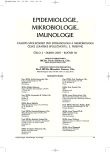Effectiveness of Aerial Application of VectoBac G Larvicide Granules Against Mosquitoes in the Olomouc Region in Spring 2006
Účinnost letecké aplikace granulovaného larvicidu VectoBac G proti komárům na jaře 2006 v Olomouckém kraji
Na jaře 2006 po rychlém tání enormního množství sněhu vznikla na Olomoucku povodňová situace, vytvořilo se množství periodických tůní a rozlevů, kde voda přetrvávala dosti dlouho. V lužních lesích došlo k předpokládanému silnému výskytu dospělců kalamitních komárů, kteří významně pronikali i do přilehlých okolních obcí. Výskyt komárů trval až do srpna včetně, podíleli se na něm komáři jarních druhů, především druh Ochlerotatus cantans a částečně i komáři letních druhů. K potlačení vzniku kalamitního stavu byla na území Olomouckého kraje poprvé použita letecká aplikace larvicidního přípravku VectoBac G na bázi Bacillus thuringiensis var. israelensis (BTI) v dávce cca 6,4 kg/ha. Na ošetřených vodních plochách se účinnost většinou blížila stu procentům. Účinek této asanace se významně projevil i v obcích v okolí ošetřených líhnišť. Nebylo však možné letecky asanovat všechna rozptýlená líhniště ani zákruty mrtvých ramen. V mnoha obcích tak postupně nálet komárů z neošetřených líhnišť vyvolal kalamitní stav a bylo nutno provádět i opakovaně plošné asanace v obcích pomocí insekticidních aerosolů. Ukazuje se, že asanace líhnišť kalamitních komárů larvicidními přípravky na bázi BTI nabízí účinné a plně selektivní vyřešení problému s výskytem kalamitních komárů. Přestože je tato technologie velmi náročná na přípravu, odbornost a organizaci, lze předpokládat, že i v České republice tento ekologicky šetrný způsob boje proti kalamitním komárům vytlačí plošné aplikace aerosolů neselektivních chemických insekticidů. Tomu by měly pomoci svým dílem i orgány ochrany veřejného zdraví, orgány správní a legislativní orgány, aby v případě hrozícího kalamitního výskytu komárů legislativní úprava umožnila použití specifických larvicidů typu BTI i na líhniště ve zvláště chráněných územích kdykoliv si to bude závažnost situace vyžadovat.
Klíčová slova:
povodně – kalamitní komáři – Bacillus thuringiensis var. israelensis – hubení larev komárů – larvicidní.
Authors:
J. Chmela; L. Mazánek; Z. Nakládal; L. Pešáková; R. Haliřová
Authors‘ workplace:
Krajská hygienická stanice Olomouckého kraje se sídlem v Olomouci
Published in:
Epidemiol. Mikrobiol. Imunol. 56, 2007, č. 2, s. 78-87
Overview
In the spring 2006, a flood emergency occurred in the Olomouc region after a rapid snow thaw, with the formation of multiple periodic pools and overflows persisting for long periods. In the floodplain forests, as expected, mass occurrence of adult mosquitoes was observed, infesting the nearby villages. The mosquito emergency continued until August and mosquitoes of both the spring species, in particular, Ochlerotatus cantans, and summer species were implicated in it. To control this emergency, aerial application of VectoBac G larvicide granules based on Bacillus thuringiensis var. israelensis (BTI) at a dose of 6.4 kg/ha was used for the first time in the Olomouc region. Its efficacy was close to 100 % for the treated water areas. The effect was clearly evident in the communities situated in the vicinity of the treated breeding grounds. Nevertheless, not all breeding grounds and blind stream meanders could be treated aerially. As a result, mosquitoes from the untreated breeding grounds caused an emergency in the nearby communities where insecticide aerosols had to be applied on a large scale, even repeatedly in some cases. The treatment of the mosquito breeding grounds with BTI based larvicide granules proved to be an effective and fully selective approach to controlling mosquitoes. Although the technology is exacting and requires professional and organizational skills, it is expected that, in the Czech Republic, this environmentally friendly approach to mosquito control will replace the large scale use of non-selective chemical aerosol insecticides. The public health protection, administrative and legislative authorities should be active in promoting the use of specific BTI based larvicides for the treatment of mosquito breeding grounds, even if located in protected areas, whenever it is needed for mosquito control in emergencies.
Key words:
flood – mosquito emergency – Bacillus thuringiensis var. israelensis – mosquito larvae control – larvicide.
Labels
Hygiene and epidemiology Medical virology Clinical microbiologyArticle was published in
Epidemiology, Microbiology, Immunology

2007 Issue 2
Most read in this issue
- Monitoring Genes Encoding Panton-Valentine Leukocidin in Staphylococcus Aureus Strains
- Pertussis: a Reemerging Infection?
- Effectiveness of Aerial Application of VectoBac G Larvicide Granules Against Mosquitoes in the Olomouc Region in Spring 2006
- Clinical Specimens for PCR Detection of Syphilis
